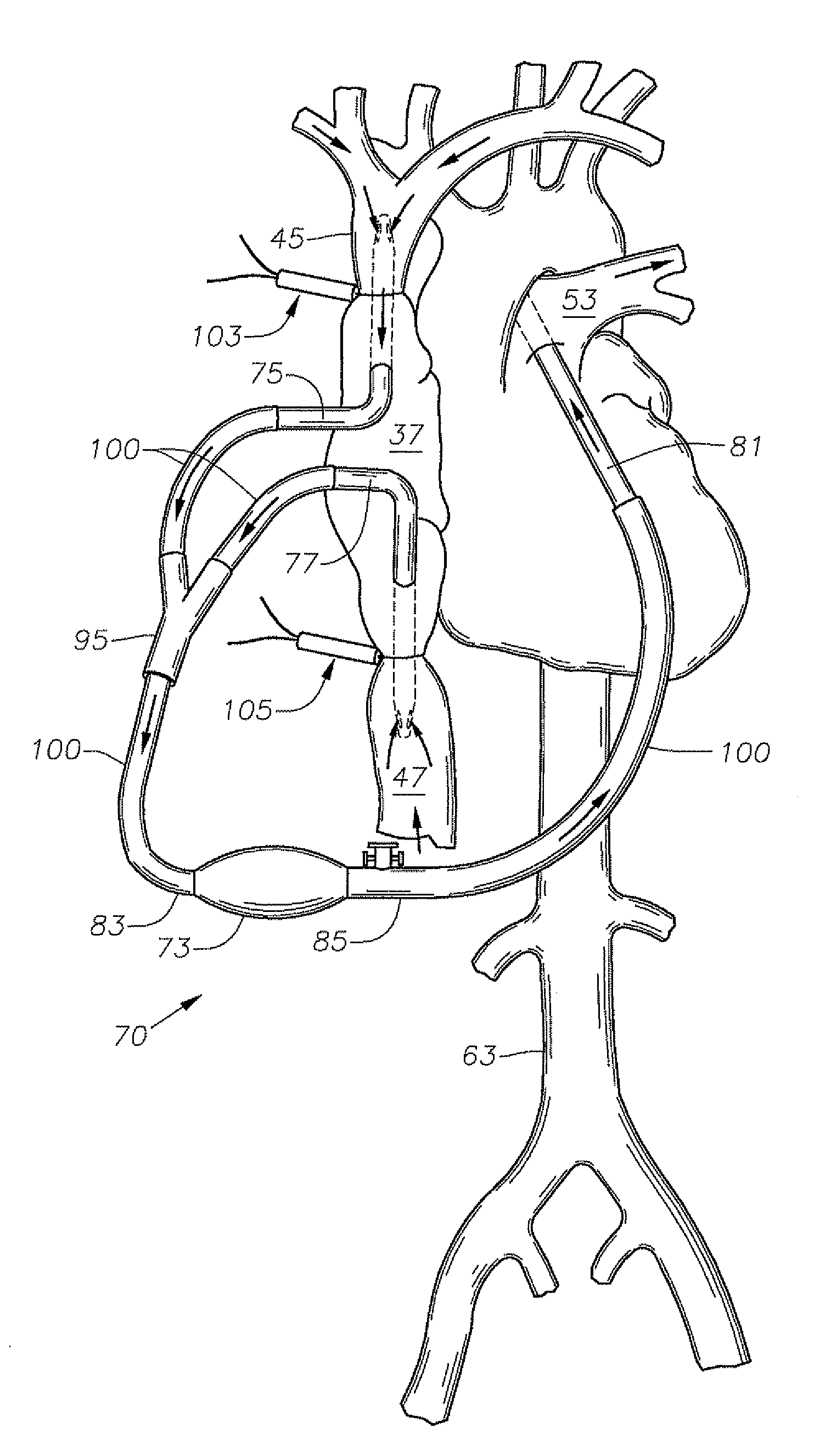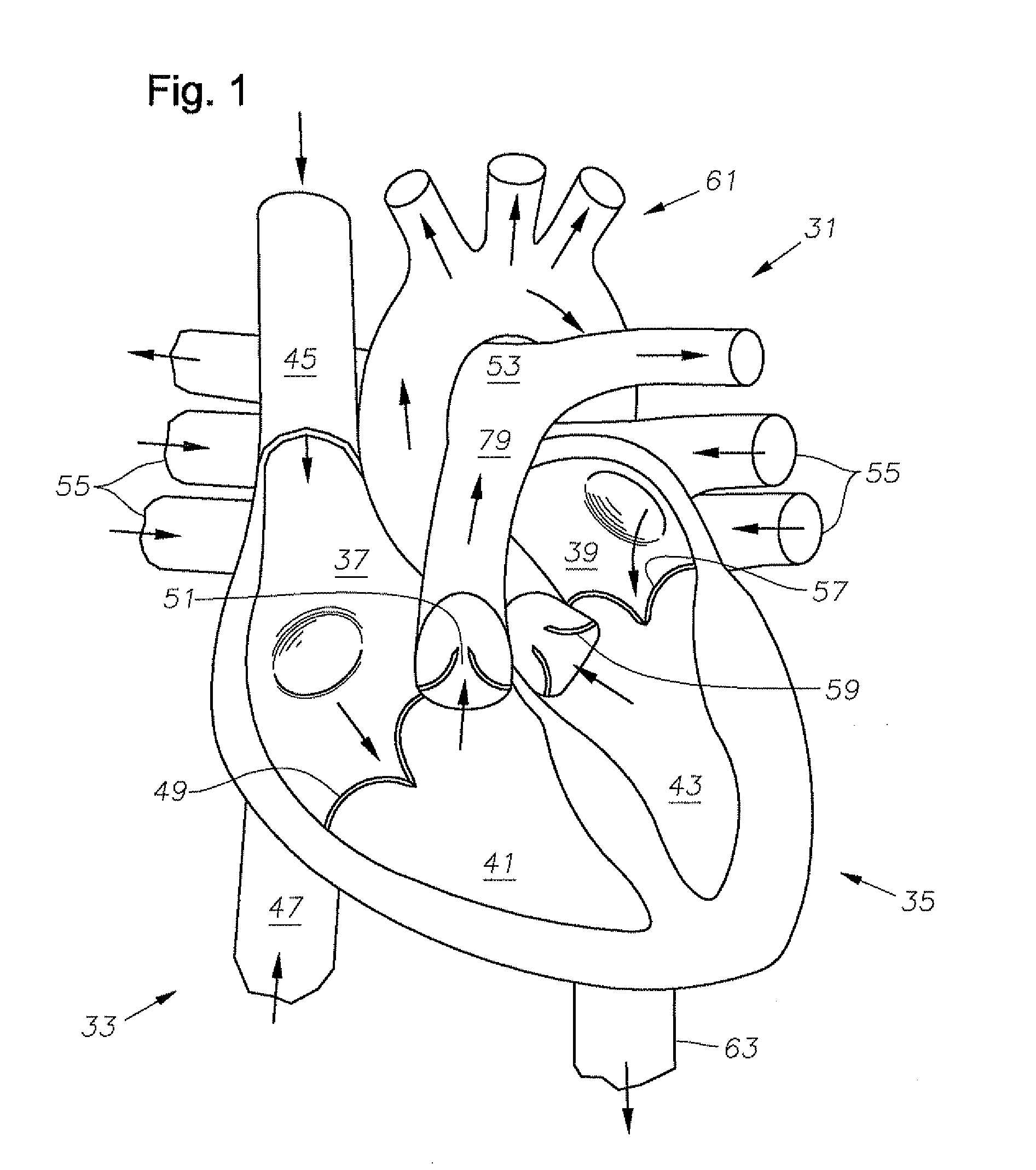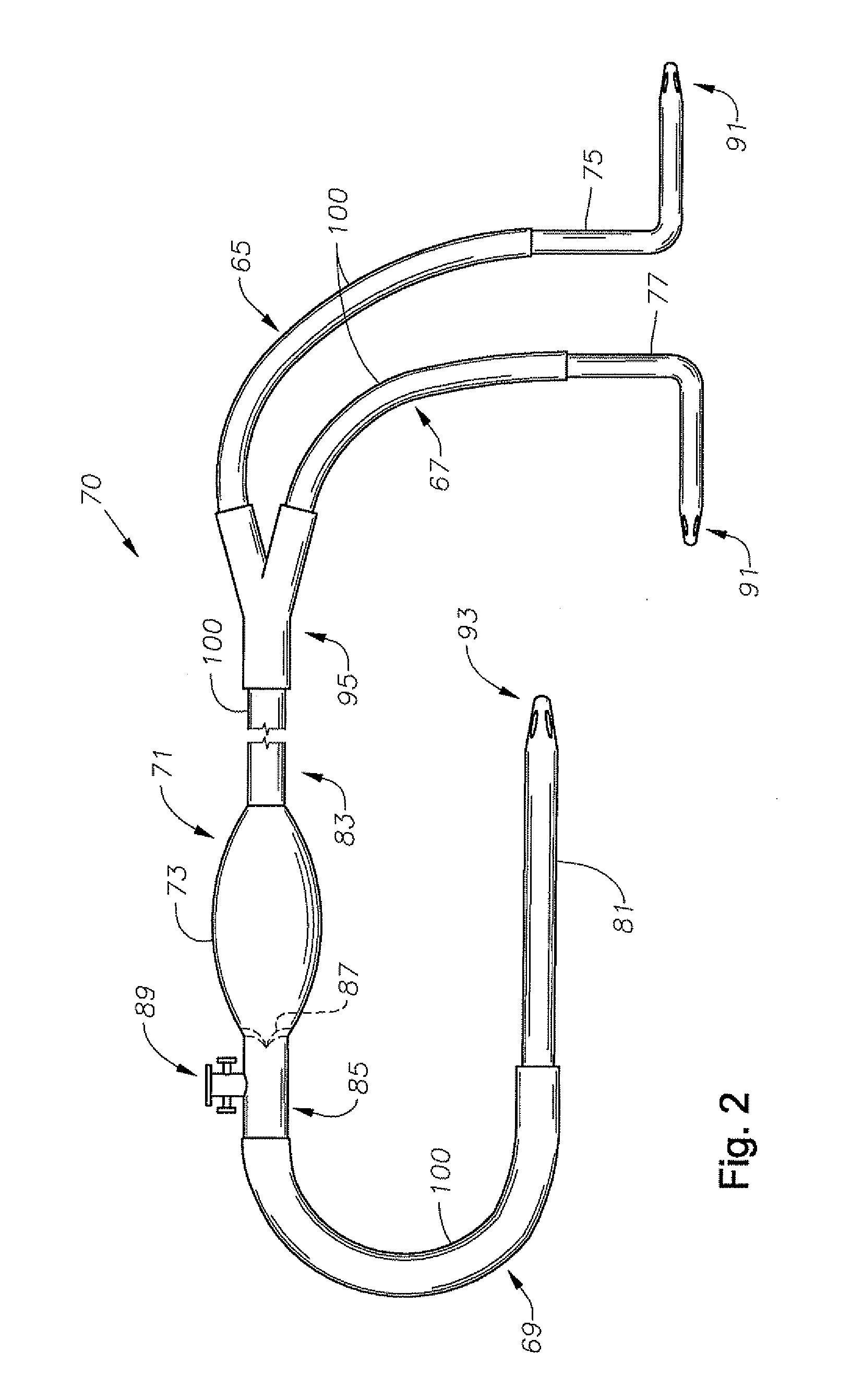[0012]In view of the foregoing, embodiments of the present invention advantageously provide an apparatus and methods to enhance the ability to perform
cardiac surgery that eliminates, or at least reduces, the need for a full
cardiopulmonary bypass (“CPB”), making feasible the performance of beating
heart bypass surgery in a substantially bloodless field. Embodiments of the present invention also advantageously provide an apparatus and methods to enhance beating heart surgery, whereby the patient's lungs are used for
blood oxygenation, to thereby avoid the need for CPB or other external
blood oxygenation equipment or procedure. That is, embodiments of the present invention include an apparatus that can maintain sufficient blood flow to the lungs, and therefore, can maintain circulatory blood flow throughout the body during, for example, open-heart surgery.
[0013]Embodiments of the present invention also advantageously provide an apparatus and methods that can provide
right heart support to include a substantially bloodless field, further making feasible beating heart surgery. In reference to embodiments of the present invention, the “right side” of the heart generally refers to and includes the vena cavae (superior and inferior), the
right atrium, the right
ventricle, the pulmonary
artery, and any combination thereof. The “right side” of the heart receives deoxygenated blood and provides blood flow to the lungs for
oxygenation prior to being returned to the left side of the heart to be circulated through the body of the patient.
[0014]Embodiments of the present invention advantageously can overcome many of the difficulties of prior systems, apparatus, and methods by providing the
surgical team positive control of blood flow, allowing the
surgical team to safely maintain good
cardiac output while performing beating heart surgery. To do so, embodiments of the present invention provide an apparatus to assist in procedures involving, for example, the right side of the heart during, thoracotomic, stemotomic, or other surgery. For example, according to an embodiment of an apparatus to assist in
surgical procedures, such as those involving the right side of the heart, such apparatus can include a first fluid conduit including, for example, a cannula having a
distal portion having a first axis and a proximal portion having a second axis oriented approximately perpendicular to the first axis to define a first right angled cannula, which is adapted to be inserted into the
superior vena cava of the beating heart to receive blood in the
superior vena cava positioned to enter the
right atrium of the beating heart; and a second fluid conduit including, for example, a cannula having a
distal portion having a first axis and a proximal portion having a second axis oriented approximately perpendicular to the first axis to define a second right angled cannula, which is adapted to be inserted into the
inferior vena cava of the beating heart to receive blood in the
inferior vena cava positioned to enter the
right atrium of the beating heart. According to an alternative embodiment of the present invention, the first and second fluid conduits can include other components adapted for
insertion into the respective vena cavae which have various other shapes / configurations as known to the skilled in the art. The apparatus can also include at least one pair of constricting straps or balloons adapted to be positioned to occlude blood flow around outer surface portions of such first and second fluid conduits / vena cavae cannulae when operatively inserted therein, to thereby prevent blood that is inbound to the right atrium from bypassing the first and second fluid conduits / vena cavae cannulae, respectively.
[0018]In the preferred configuration, the pump is, for example, a hand-operated pump having a main body such as in the form of a
bulb syringe, which can act as a blood reservoir. When implemented on a patient, e.g., when each of the cannulas are operatively inserted, the apparatus can form a closed extracardiac pathway from the vena cavae to the pulmonary
artery of the beating heart. Advantageously, when blood flow is sufficient, the apparatus can allow a continuous and unassisted flow of blood between the vena cavae and pulmonary
artery (and thus, the lungs) through the pump so that, for example, when implemented to bypass portions of the right side of the heart with the left side of the heart beating normally, at least to some substantial extent, portions of the
blood pressure to the lungs is provided by the left side of the heart. When blood flow is insufficient, the
bulb syringe can be compressed manually to manually assist the pumping of blood into the lungs. Further, the pump can include a checkvalve to prevent a
backflow of blood from the pulmonary artery. Still further, the inlet and the outlet to the
bulb syringe can be sized so that synergistically, when the bulb syringe is compressed, the blood in the syringe more readily passes through the outlet than through the inlet. This can be accomplished, for example, by having an inlet smaller than the outlet.
[0020]Embodiments of the present invention also provide methods of assisting procedures involving the right side of the heart of a patient. For example, a method can include inserting at least portions of a first fluid conduit into the superior
vena cava of the beating heart to thereby receive substantially all blood in the superior
vena cava positioned to enter the right atrium of the beating heart; inserting at least portions of a second fluid conduit into the inferior
vena cava of the beating heart to thereby receive substantially all blood in the inferior vena cava positioned to enter the right atrium of the beating heart; and inserting at least portions of a third fluid conduit into the pulmonary artery of the beating heart, to receive and deliver to the pulmonary artery substantially all blood flow collected from the superior and inferior vena cavae. That is, the first fluid conduit, the second fluid conduit, and the third fluid conduit in combination can form at least portions of an extracardiac pathway to convey into the pulmonary artery the substantially all blood collected from the superior vena cava and the substantially all blood collected from the inferior vena cava to thereby provide a substantially complete and preferably unassisted blood flow from the vena cavae to the lungs of the patient undergoing a cardiac procedure. The method can also include pumping blood, e.g., manually, through the extracardiac pathway when blood flow to the lungs of a patient undergoing a cardiac procedure is insufficient to thereby control the blood flow to the lungs of the patient.
[0022]Advantageously, the methods and apparatus made according to embodiments of the present invention, are extraordinarily simple to employ and can be readily used, for example, in procedures for
Tricuspid valve,
Atrial septum,
Right Atrial tumors excision and Off Pump
Coronary Artery Bypass Surgery, although others are within the scope of the present invention.
 Login to View More
Login to View More  Login to View More
Login to View More 


